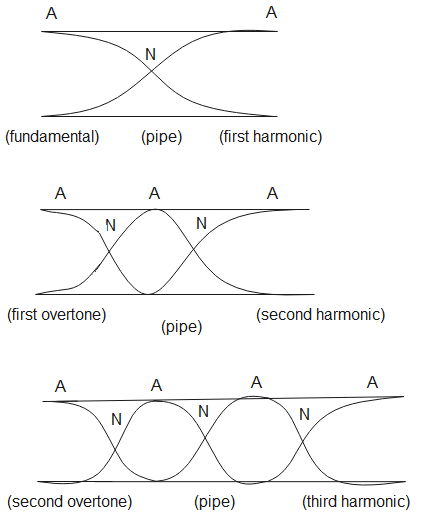
The third harmonic in an open organ pipe is known as
A. Fundamental frequency
B. Second overtone
C. Third overtone
D. First overtone
Answer
452.1k+ views
Hint: The lowest natural frequency of a system is called Fundamental frequency, while the higher frequencies are known as Overtones. The term overtone is used to describe any resonant frequency above the fundamental frequency.
Complete step-by-step solution:
The instruments which are used to produce sound by blowing into a pipe are known as organ pipes, they are of two types; closed organ pipes, which are closed at one and open organ pipes, which are open at both ends.
For closed organ pipe,
${{f}_{0}}=\dfrac{v}{4L}$
Here, ${{f}_{0}}$ is the fundamental frequency
$v$ is the velocity of sound
$L$ is the length of the tube and $4L$ is the wavelength of the wave
${{f}_{1}}=3{{f}_{0}}$, ${{f}_{2}}=5{{f}_{0}}$ and so on
For an open organ pie,
${{f}_{0}}=\dfrac{v}{2L}$
Here, $2L$ is the wavelength of the wave
${{f}_{1}}=2{{f}_{0}}$, ${{f}_{2}}=3{{f}_{0}}$ and so on
The note produced by an open organ pipe consists of both even and odd harmonics but the notes produced by open organ pipe comprises odd harmonics only.
The lowest frequency of a periodic waveform is known as the fundamental frequency of a pipe. The higher frequencies are known as overtones.
The representation of harmonics in an open organ pipe is as follows
The A represents the antinode, and N represents the node

Overtone is a term used to specify any higher standing wave and the term harmonic is used for those cases in which the overtones are integral multiples of fundamental frequency.
The third harmonic in an open organ pipe is known as the second overtone. Hence, the correct option is (B).
Note: All harmonics are overtones but all overtones are not harmonics. The node is the point on the wave where resultant amplitude is zero while antinodes are those points where resultant amplitude is maximum. As the number of harmonics increase, the wavelength decreases.
Complete step-by-step solution:
The instruments which are used to produce sound by blowing into a pipe are known as organ pipes, they are of two types; closed organ pipes, which are closed at one and open organ pipes, which are open at both ends.
For closed organ pipe,
${{f}_{0}}=\dfrac{v}{4L}$
Here, ${{f}_{0}}$ is the fundamental frequency
$v$ is the velocity of sound
$L$ is the length of the tube and $4L$ is the wavelength of the wave
${{f}_{1}}=3{{f}_{0}}$, ${{f}_{2}}=5{{f}_{0}}$ and so on
For an open organ pie,
${{f}_{0}}=\dfrac{v}{2L}$
Here, $2L$ is the wavelength of the wave
${{f}_{1}}=2{{f}_{0}}$, ${{f}_{2}}=3{{f}_{0}}$ and so on
The note produced by an open organ pipe consists of both even and odd harmonics but the notes produced by open organ pipe comprises odd harmonics only.
The lowest frequency of a periodic waveform is known as the fundamental frequency of a pipe. The higher frequencies are known as overtones.
The representation of harmonics in an open organ pipe is as follows
The A represents the antinode, and N represents the node

Overtone is a term used to specify any higher standing wave and the term harmonic is used for those cases in which the overtones are integral multiples of fundamental frequency.
The third harmonic in an open organ pipe is known as the second overtone. Hence, the correct option is (B).
Note: All harmonics are overtones but all overtones are not harmonics. The node is the point on the wave where resultant amplitude is zero while antinodes are those points where resultant amplitude is maximum. As the number of harmonics increase, the wavelength decreases.
Recently Updated Pages
The correct geometry and hybridization for XeF4 are class 11 chemistry CBSE

Water softening by Clarks process uses ACalcium bicarbonate class 11 chemistry CBSE

With reference to graphite and diamond which of the class 11 chemistry CBSE

A certain household has consumed 250 units of energy class 11 physics CBSE

The lightest metal known is A beryllium B lithium C class 11 chemistry CBSE

What is the formula mass of the iodine molecule class 11 chemistry CBSE

Trending doubts
State the laws of reflection of light

One Metric ton is equal to kg A 10000 B 1000 C 100 class 11 physics CBSE

Difference Between Prokaryotic Cells and Eukaryotic Cells

What is the modal class for the following table given class 11 maths CBSE

How do I convert ms to kmh Give an example class 11 physics CBSE

Give an example of a solid solution in which the solute class 11 chemistry CBSE




